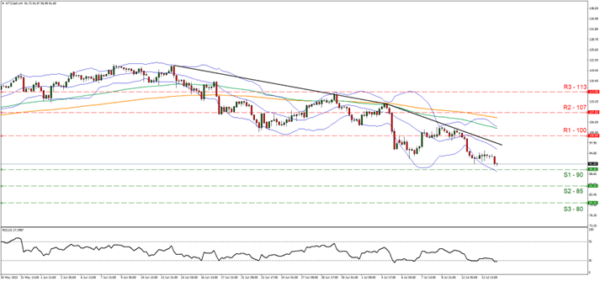As global economic conditions continue to stroll casually towards deterioration, the market scrambles to reappraise the possibility for a recession. Contributing to the worsening of the economic outlook, is the soaring inflation, with year-on-year US consumer price index, reaching levels once seen before in 1981, marking a four-decade high, which puts increased pressure on the Fed to adopt an even more hawkish stance. Not only that, but the inversion of the yield curve also points out that the market anticipates economic fallout, sooner rather than later, as we observed increased volatility in the bond market around the CPI release. As a consequence, WTI slipped lower yesterday 13th of July, closing the day around the $94 per barrel. In this report we aim to provide a comprehensive analysis on the current economic developments, draw a picture on what could lie ahead and finish off with a technical analysis of WTI.
US Secretary Treasury Yellen, embarked on a new crusade mission towards the far east, attempting to encourage G20 members, to opt-in the price-capping plan on Russian oil. The price cap aims to prevent another global price spike in the energy sector, by allowing the flow of Russian oil towards the west and in parallel restrict the revenues, Russia uses to finance its war operations in Ukraine. Problems arising with the price proposal include, how to enforce the plan, what would the proposed sales price be and whether the other counterparts will subscribe to the idea. Furthermore, another factor outside of western control is whether Russia will agree to sell oil at the “mandated” price to western nations. This highlights the fragmented microcosmic perspective of westerners on the matter, naively assuming that Russia cannot and will not divert their oil exports towards, other non-western nations such as India and China. Without much surprise, the proposed plan triggered President Putin’s reaction, lashing out and threatening the western nations for “catastrophic consequences” for world energy markets, if they impose further sanctions on Moscow. Characteristically, on another note, currently Nord Stream 1 pipeline which supplies natural gas to Europe, is closed for maintenance, but analysts fear the reopening could be delayed as a retaliation tactic, by Russian government.
President Biden is to visit the Saudi Arabian oil mogul royalties, pitching for a production boost this weekend. Even though, it appears Saudi Arabia, the top crude oil producer, currently runs at maximum output capacity according to OPEC, the expected output increases to be discussed at the meeting will take place in the near future. Noteworthy, are the major OPEC players, such as Nigeria and Libya who are facing production and export limitations, failing to deliver promises, due to sociopolitical unrest and operational hurdles respectively. Should the meeting with Biden and Saudis fail to produce any increase in production levels in the near future, that could cause practically the price of oil to rise as it would imply the possible shortage of the supply of the commodity.
Turning our attention towards yesterday’s key economic releases we noticed that the market reaction was rather contradictory, diverging from fundamental market expectations. As an example, the surprise actual YoY CPI rate of 9.1% contrasted with the 8.8% forecast, should have in our assessment, pushed the greenback to higher grounds, a scenario wherein the strong US dollar would weigh down WTI’s price. On the contrary, we saw the dollar closing the day in the reds whilst oil closed in the greens. Moreover, US Crude Oil Inventories release reported surpluses by both the American Petroleum Institute as well as the Energy Information Administration failed to weigh on oil’s price, despite implying a slack in the US oil market. Thus, we maintain a bearish bias outlook for the continuation of WTI’s price action in the short-term horizon.
As to what follows, the Baker Hugh’s oil rig count will be out tomorrow 15th of July, which will shed some light on the demand-side of oil. In the grand scheme of things, we expect oil prices to be affected by supply and demand fundamentals. Should market worries for a possible supply shortage intensify, we may see oil prices getting a boost, while on the flip side should market worries for a possible recession and lockdown measures in China come into play, we may see the demand expectations of oil dropping, thus weigh on oil’s prices.
Technical Analysis
WTI H4
WTI continues to move in a downward trend, as we can observe the lower peaks and lower troughs forming a descending trendline. WTI currently trades around the $91 range aiming for the $90 (S1) having the $100 psychological level as closest resistance (R1). We tend to have a propensity for a continuation towards a downwards motion, as we believe that a breaking through the $90 support (S1) line and $85 support (S2) barrier its within WTI’s reach, in the short-term horizon. Supporting our case, the RSI indicator below our 4-hour chart is nearing the reading of 30. Also, given the fundamentals described above, there could be a substantial possibility for the price to experience volatility and head further down. Should WTI find extensive buy orders along its way, we may see its price action breaking through the descending trendline first, signaling a possible trend reversal, then followed by a break above the $100 psychological resistance (R1) line and moving decisively towards the $107 resistance (R2) hurdle. Should selling interests continue to be seen, we may see its price breaking the $90 (S1) support line, a level not seen since February 2022, and move decisively lower, aiming for the $85 support (S2) level.



 Signal2forex.com - Best Forex robots and signals
Signal2forex.com - Best Forex robots and signals




